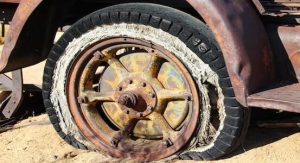
Combatting Congestion
February 6, 2019
Highlighting Trucking Reform
February 27, 2019(Re)creating the Wheel

Don’t Tread on Me
Take a ride down memory lane for a moment: You’re pedaling on your Huffy bicycle. The trip seems harder. It’s more difficult to pedal. Oh, it’s your under-inflated tires. Sure, unless there’s absolutely no air in the tubes and you’re riding on the rims, you’ll get home. It’ll just take you longer and require more work. You get home, pump up the tires. Your rides are back to smooth.
Now apply that same scenario to your vehicle. Under-inflated tires cost drivers time, fuel money, and wear and tear on the rest of the vehicle. Truck pulling to the left or right? Could be the steering is out of whack. The more likely—and more common—answer is that one or more of your tires are under-inflated.
Fleet Equipment quotes Sharon Cowart, product marketing director for Michelin:
“Under-inflation is the biggest issue in the industry. It’s the number one cause of premature tire removal. “Under-inflated tires build up excessive heat that can result in tire destruction and/or improper vehicle handling. In addition, it can result in irregular wear and poor fuel economy. If a fleet invests in low rolling resistant, fuel-efficient tires and then does not maintain the optimum inflation pressure, they may not benefit from the fuel economy expected.”
Under-inflated tires can impact tread wear by some 25%. Under-inflation by 10 PSI can reduce fuel economy by one percent.
And then there’s over-inflation. That scenario can reduce traction and create a wear pattern that’s not in synch with the other tires.
It’s no surprise that technology is turning to our tires. No doubt, we’ll see smart tires sooner or later. As Motherboard reported, “electrical engineers at Duke University created a printed sensor that can monitor the tread of car tires in real time, alerting drivers when the rubber hitting the road has grown dangerously thin.”
If air pressure is the problem, how about a tire with no air? Yes, that’s in the works, too: Bridgestone has developed the “Air Free Concept,” a tire that employs spokes instead of air. While the company has focused this on bicycles, we can readily see the same concept rolled out to larger vehicles.
In the meantime, keep those tires inflated.

